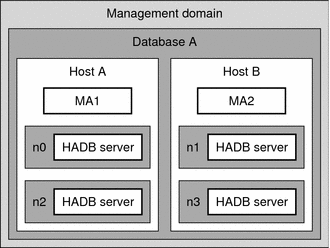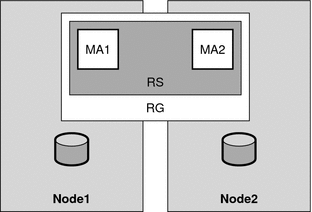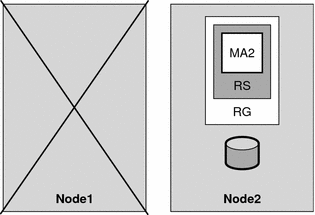Sun Cluster HA for Sun Java System Application Server EE (HADB) Overview
This section describes how the Sun Cluster HA for Sun Java System Application Server EE (HADB) data service enables the Management Agent component of Sun Java System Application Server EE (HADB) to be highly available in a Sun Cluster system. The data service must be configured to be mastered by multiple nodes.
See Chapter 1, Planning for Sun Cluster Data Services, in Sun Cluster Data Services Planning and Administration Guide for Solaris OS for general information about data services. The data service must be configured
The Sun Java System Application Server EE (HADB) software is packaged with the Sun Java System Application Server Enterprise Edition installation. However, you can run Sun Java System Application Server EE (HADB) and Sun Java System Application Server on separate clusters if appropriate. This document describes how to install and configure the data service that enables you to use Sun Java System Application Server EE (HADB) in a cluster. First, enable Sun Java System Application Server EE (HADB) in your cluster to provide session and Enterprise Java Bean (EJB) persistence. Refer to Sun Java System Application Server documentation for information about Sun Java System Application Server EE (HADB).
Implementation of the Sun Cluster HA for Sun Java System Application Server EE (HADB) does not assume the existence of applications on which your architecture depends, such as databases and web servers. However, such applications can be configured to be highly available and might run on a different cluster.
HADB Management Architecture
The following figure illustrates the architecture of a database with four active nodes in a management domain.
Figure 1–1 Management System Architecture

The figure illustrates a management domain that consists of a database and four HADB node processes in the database. These node processes are indicated by n0, n1, n2, and n3. Host A and Host B represent the cluster nodes and form the Data Redundancy Units, or DRUs (Host A:DRU0 and Host B:DRU1) for HADB.
Management agent MA1 manages n0 and n2, and management agent MA2 manages n1 and n3. The management agent is responsible for monitoring the health of the node and restarting the node when necessary. The management agent also handles the management operations requests from the clients.
If the management agent fails on the cluster node, the agent must be restarted on the same node so that the agent can continue to monitor the HADB nodes and to provide management operations. Therefore, the management agent must be made highly available.
Highly Available HADB Management Agent
The Management Agent component of Sun Java System Application Server EE (HADB) is made highly available by creating a data service resource in a resource group that is configured to be mastered by multiple nodes at the same time. In this resource group, the maximum number of primary nodes and the desired number of primary nodes must be the same. This configuration is described in detail in Registering and Configuring the Sun Cluster HA for Sun Java System Application Server EE (HADB).
The following figure illustrates a two-node configuration before any failure occurs on a node.
Figure 1–2 Management Agents Mastered on Multiple Nodes—Before Failure

The figure illustrates two management agents, indicated by MA1 and MA2, on different cluster nodes. The application is installed on the local file system on each node. With the Sun Cluster HA for Sun Java System Application Server EE (HADB) data service, the two management agents are configured in one resource, indicated by RS, and this resource is configured in one resource group, RG. The resource group is configured to be mastered on multiple cluster nodes at one time, in this case, Node1 and Node2.
The data service manages starting the management agents on all the nodes on which they are configured. The management agents in turn start the Node Supervisor (NSUP) process, which then starts the HADB node processes. If a management agent fails, the data service restarts it, based on user-defined parameters. If the HADB node processes fail, the management agent restarts them. If any databases have stopped, the user must restart these databases by issuing commands on the command line.
If the user-defined parameters determine that the data service does not restart the management agent after a failure, the processes remain down on that node. However, the management agent processes on the other managed nodes continue to execute. No failover occurs.
The following figure illustrates the two-node configuration after the failure of the first node. All the processes on the first node are down, and the second node continues to execute its processes.
Figure 1–3 Management Agents Mastered on Multiple Nodes—After Failure

- © 2010, Oracle Corporation and/or its affiliates
